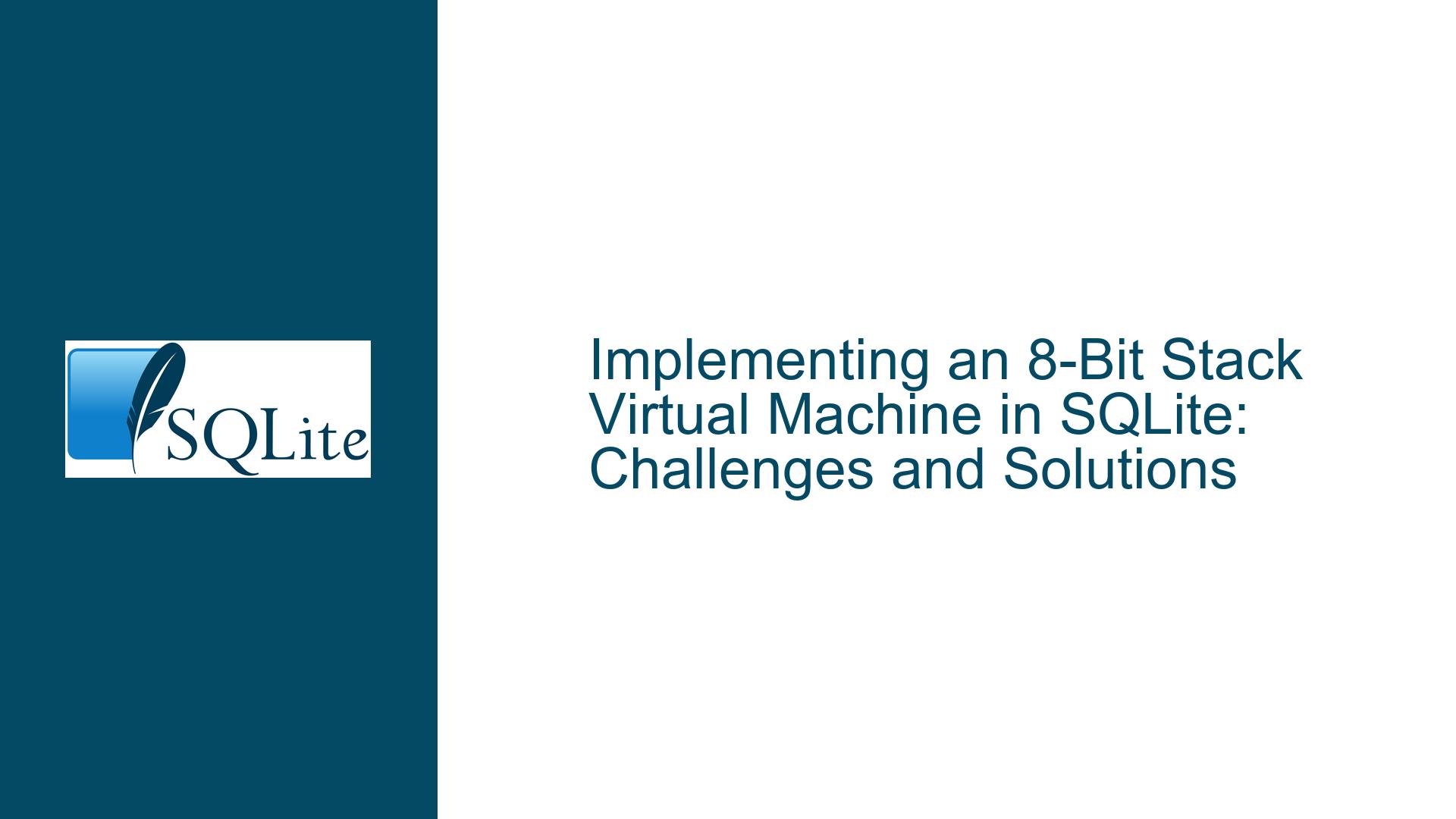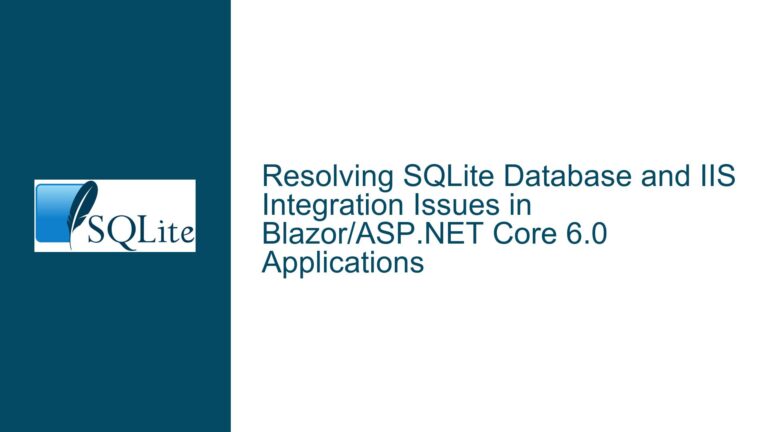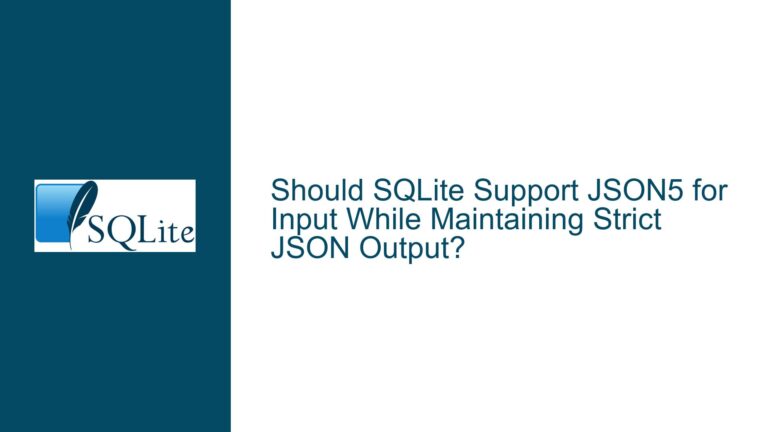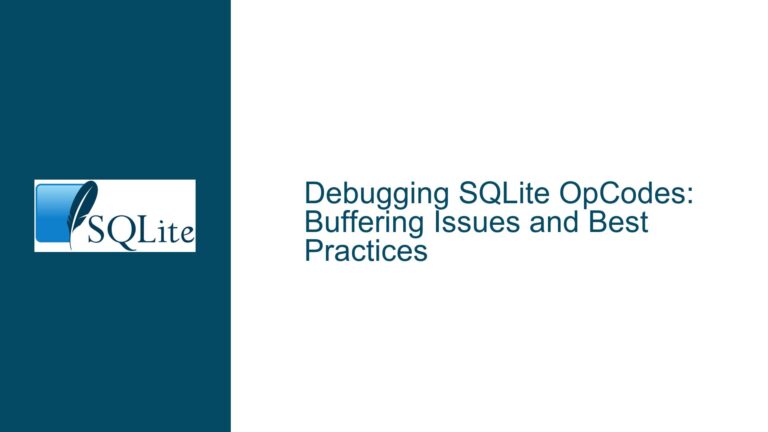Implementing an 8-Bit Stack Virtual Machine in SQLite: Challenges and Solutions
Understanding the 8-Bit Stack Virtual Machine Implementation in SQLite
The concept of implementing an 8-bit stack virtual machine in SQLite is both fascinating and complex. At its core, this implementation involves using SQLite’s relational database capabilities to simulate a virtual machine that operates on an 8-bit stack architecture. The virtual machine is designed to execute programs stored in a table, leveraging SQLite’s WITH RECURSIVE clause to handle the execution flow. This approach is unconventional, as SQLite is typically used for data storage and retrieval rather than computational tasks. However, the implementation demonstrates the flexibility of SQLite and its ability to handle recursive queries, which are essential for simulating the execution of a program in a virtual machine.
The virtual machine operates by storing its program instructions in a table, where each row represents an instruction. The instructions are executed sequentially, with the WITH RECURSIVE clause enabling the virtual machine to iterate through the program steps. The stack, which is a fundamental component of the virtual machine, is also implemented using SQLite tables. The stack operations, such as push and pop, are performed using SQL queries that manipulate the stack table. This design allows the virtual machine to maintain its state across multiple instructions, enabling it to execute complex programs.
One of the key challenges in this implementation is ensuring that the virtual machine can handle the recursive nature of program execution efficiently. The WITH RECURSIVE clause is powerful but can be computationally expensive if not used carefully. Additionally, the virtual machine must manage the stack operations correctly to avoid errors such as stack overflows or underflows. These challenges require a deep understanding of both SQLite’s capabilities and the principles of stack-based virtual machines.
Potential Pitfalls in the 8-Bit Stack Virtual Machine Design
The implementation of an 8-bit stack virtual machine in SQLite introduces several potential pitfalls that can affect its performance and correctness. One of the primary concerns is the efficiency of the WITH RECURSIVE clause. While this clause is essential for simulating the execution flow of the virtual machine, it can lead to performance issues if the recursion depth is too high or if the queries are not optimized. SQLite is not inherently designed for heavy computational tasks, and recursive queries can quickly become a bottleneck, especially for large programs.
Another potential issue is the management of the stack. In a traditional stack-based virtual machine, the stack is a simple data structure that allows for fast push and pop operations. However, in SQLite, the stack is implemented as a table, which means that each push or pop operation requires an SQL query. This can lead to significant overhead, particularly if the stack is frequently accessed. Additionally, the stack table must be carefully managed to ensure that it does not grow indefinitely, which could lead to memory issues.
Data integrity is also a concern in this implementation. Since the virtual machine relies on SQLite tables to store both the program instructions and the stack, any corruption or inconsistency in these tables can lead to incorrect program execution. Ensuring data integrity requires careful design of the database schema and the use of transactions to maintain consistency. Furthermore, the virtual machine must handle errors gracefully, such as invalid instructions or stack underflows, to prevent the program from crashing.
Finally, the design of the virtual machine must consider the limitations of SQLite itself. SQLite is a lightweight database engine that is not designed for high-performance computing. While it is capable of handling complex queries, it may not be the best choice for tasks that require intensive computation or real-time performance. The virtual machine implementation must therefore be optimized to work within these constraints, which may involve trade-offs in terms of functionality or performance.
Strategies for Optimizing and Debugging the SQLite-Based Virtual Machine
To address the challenges and potential pitfalls of implementing an 8-bit stack virtual machine in SQLite, several strategies can be employed to optimize and debug the system. The first step is to optimize the use of the WITH RECURSIVE clause. This can be achieved by minimizing the recursion depth and ensuring that the recursive queries are as efficient as possible. One approach is to break down the program into smaller segments and execute them sequentially, rather than relying on a single recursive query to handle the entire program. This can reduce the computational load and improve performance.
Another strategy is to optimize the stack operations. Since the stack is implemented as a table, each push or pop operation involves an SQL query. To reduce the overhead, the stack table can be indexed to speed up access. Additionally, the stack operations can be batched, where multiple push or pop operations are combined into a single query. This can reduce the number of queries executed and improve performance. It is also important to monitor the size of the stack and implement mechanisms to prevent it from growing too large, such as limiting the maximum stack size or implementing garbage collection.
Data integrity can be ensured through careful design of the database schema and the use of transactions. The schema should be designed to enforce constraints and relationships between tables, such as ensuring that each instruction in the program table references a valid operation. Transactions can be used to ensure that changes to the stack or program state are atomic, consistent, isolated, and durable (ACID). This can prevent data corruption and ensure that the virtual machine operates correctly.
Error handling is another critical aspect of the virtual machine implementation. The virtual machine must be able to detect and handle errors such as invalid instructions, stack underflows, or stack overflows. This can be achieved by implementing checks in the SQL queries and using conditional logic to handle errors gracefully. For example, if an invalid instruction is encountered, the virtual machine can log the error and halt execution, rather than attempting to execute the invalid instruction.
Finally, it is important to consider the limitations of SQLite and design the virtual machine accordingly. While SQLite is a powerful tool, it is not designed for high-performance computing. Therefore, the virtual machine implementation should be optimized to work within these constraints. This may involve simplifying the program instructions, reducing the complexity of the stack operations, or limiting the size of the program. By carefully considering these factors, the virtual machine can be implemented in a way that is both efficient and reliable.
In conclusion, implementing an 8-bit stack virtual machine in SQLite is a challenging but rewarding task. By understanding the core concepts, identifying potential pitfalls, and employing strategies for optimization and debugging, it is possible to create a functional and efficient virtual machine that leverages the power of SQLite. While there are limitations to what can be achieved with SQLite, this implementation demonstrates the flexibility and versatility of the database engine, and serves as a valuable learning experience for those interested in both SQLite and virtual machine design.






